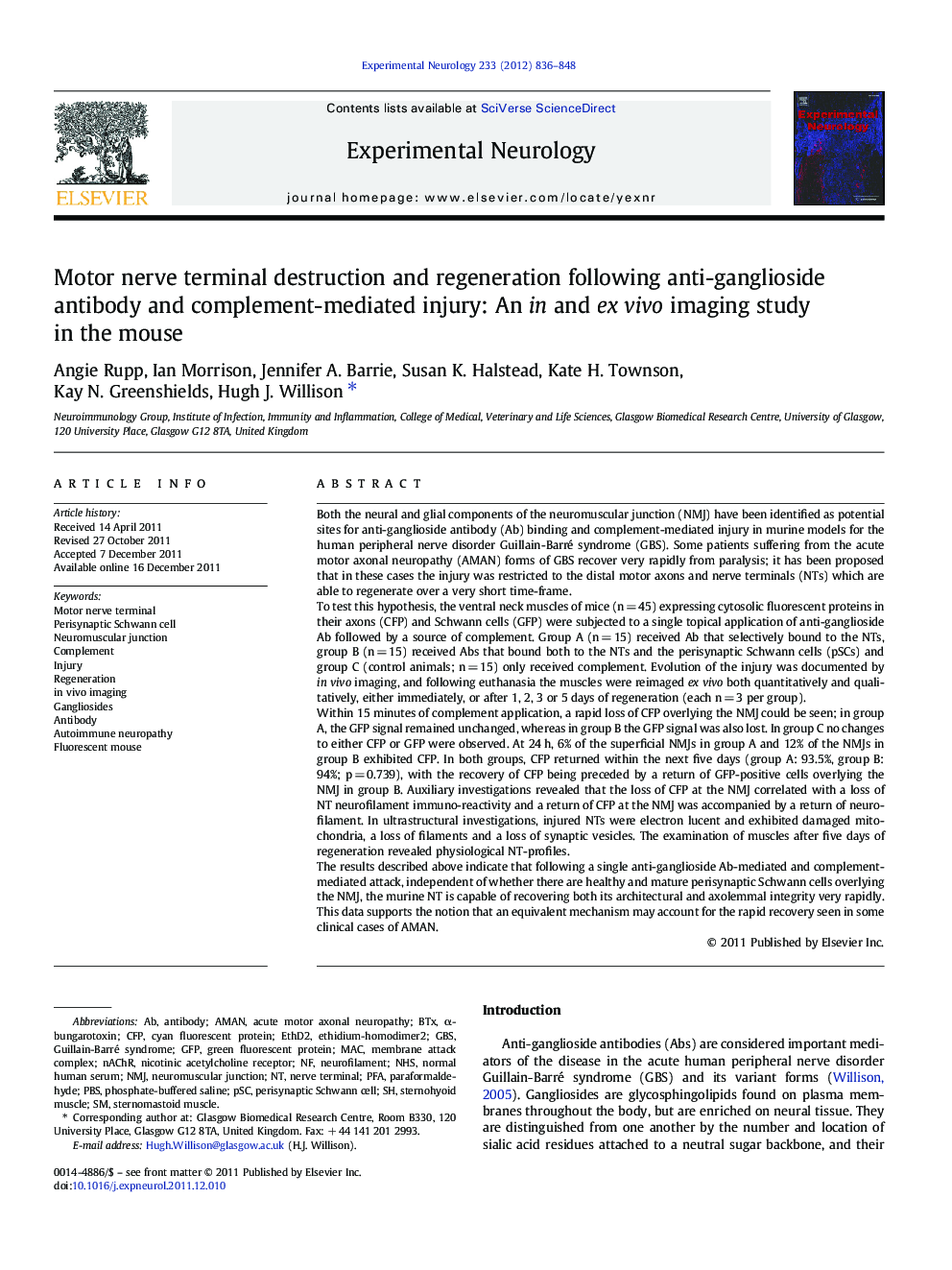| کد مقاله | کد نشریه | سال انتشار | مقاله انگلیسی | نسخه تمام متن |
|---|---|---|---|---|
| 6019018 | 1186531 | 2012 | 13 صفحه PDF | دانلود رایگان |

Both the neural and glial components of the neuromuscular junction (NMJ) have been identified as potential sites for anti-ganglioside antibody (Ab) binding and complement-mediated injury in murine models for the human peripheral nerve disorder Guillain-Barré syndrome (GBS). Some patients suffering from the acute motor axonal neuropathy (AMAN) forms of GBS recover very rapidly from paralysis; it has been proposed that in these cases the injury was restricted to the distal motor axons and nerve terminals (NTs) which are able to regenerate over a very short time-frame.To test this hypothesis, the ventral neck muscles of mice (n = 45) expressing cytosolic fluorescent proteins in their axons (CFP) and Schwann cells (GFP) were subjected to a single topical application of anti-ganglioside Ab followed by a source of complement. Group A (n = 15) received Ab that selectively bound to the NTs, group B (n = 15) received Abs that bound both to the NTs and the perisynaptic Schwann cells (pSCs) and group C (control animals; n = 15) only received complement. Evolution of the injury was documented by in vivo imaging, and following euthanasia the muscles were reimaged ex vivo both quantitatively and qualitatively, either immediately, or after 1, 2, 3 or 5 days of regeneration (each n = 3 per group).Within 15 minutes of complement application, a rapid loss of CFP overlying the NMJ could be seen; in group A, the GFP signal remained unchanged, whereas in group B the GFP signal was also lost. In group C no changes to either CFP or GFP were observed. At 24 h, 6% of the superficial NMJs in group A and 12% of the NMJs in group B exhibited CFP. In both groups, CFP returned within the next five days (group A: 93.5%, group B: 94%; p = 0.739), with the recovery of CFP being preceded by a return of GFP-positive cells overlying the NMJ in group B. Auxiliary investigations revealed that the loss of CFP at the NMJ correlated with a loss of NT neurofilament immuno-reactivity and a return of CFP at the NMJ was accompanied by a return of neurofilament. In ultrastructural investigations, injured NTs were electron lucent and exhibited damaged mitochondria, a loss of filaments and a loss of synaptic vesicles. The examination of muscles after five days of regeneration revealed physiological NT-profiles.The results described above indicate that following a single anti-ganglioside Ab-mediated and complement-mediated attack, independent of whether there are healthy and mature perisynaptic Schwann cells overlying the NMJ, the murine NT is capable of recovering both its architectural and axolemmal integrity very rapidly. This data supports the notion that an equivalent mechanism may account for the rapid recovery seen in some clinical cases of AMAN.
⺠We model complement-mediated injury to the motor nerve terminal in fluorescent mice. ⺠We examine injury in vivo and regeneration ex vivo. ⺠Nerve terminals recover within five days. ⺠This includes axolemmal integrity, structural proteins and ultrastructural morphology. ⺠Recovery is independent of mature and healthy perisynaptic Schwann cells.
Journal: Experimental Neurology - Volume 233, Issue 2, February 2012, Pages 836-848